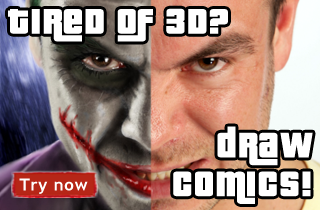“Cow” by Matt Dixon
“This image was painted in Adobe Photoshop. I’m often asked about my brushes and painting technique; I hope the steps below go some way to explain how I approach a painting. I use my own custom brushes, but there’s nothing particularly unusual or clever about them – most of the painting is done with brushes very similar to the ‘Natural Brush’ set that ships with PS v.7 and above.”
1) Rough lines. This is a fairly simple image, so I’m not really concerned with working out any details at this point. If the pic were more challenging, with multiple characters in action, tricky anatomy or complicated costume for example, I’d spend a little more time trying to tackle any areas that might cause problems during this stage.

3Dtutorials.sk recommendation:
To maximise the realism of your CG characters we recommend to use high quality photo references from the #1 reference website www.human-anatomy-for-artist.com
2) Underpainting. With the linework established ( this step shows some minor tweaks to the sketch in step 1 ), I move it onto a second layer set to multiply and drop the opacity a little. Then I apply a very loose underpainting to the layer below using a large soft brush – once again, the pic dictates how much time I spend on this, here it’s not very long at all! For me, the most important part of this stage is to dispose of the scary white canvas and to give something interesting to paint against but the colours used at this stage can have a dramatic impact on the finished piece, so they should be chosen carefully. Once this step is finished, the pic is flattened again – that’s the last time I’ll use layers until the very final tweaks. Painting on a single layer really seems to help keeping the image looking organic – I always end up working on the wrong layer if I have more than two or three active anyway..!

3) Partial lay in. Here I’m trying to lay down the basic colours to render against and define the significant forms. Even though the background is going to be a simple abstracted sky, I’m working this up as I go along in the same way as the rest of the image. You can see some little swatches drawn on the left which I use to pick up basic colours – as the painting develops I’ll be colour picking from colours already in use on the canvas.

4) Completed lay in. Most of the pic is now tidied up and painted with fairly flat mid to dark tones, ready for rendering. I’m using a variety of sizes and shapes of brush here and making bold, opaque marks – I find that helps to build of texture and gives me something to work into as I proceed.

5) Modelling. Painting in lighter and darker tones to give things more solidity, and to further define the lighting. You can see the remains of an arrow drawn during the lay in near the top left corner to remind me of the direction of the lightsource.

6) Detailing. Almost ready to go for the finish now, so it’s time to make sure all the details are in place. I’ve also softened some edges to try and push focus to the more important areas and add a bit of depth. I knew I wanted something hanging from the totem she’s carrying, but it’s only at this point that I decide on a stubby pencil and Wacom pen; in this case the finished pic actually looks a lot like my first sketch, but I’m much more comfortable reacting to what’s happening on the canvas than trying to force my initial thoughts to appear exactly as intended, so there are usually a lot more of these little changes and additions in my work than you see in this image.

7) Rendering. Nearly there now. Here I’m trying to emphasize the difference between the materials with the application of some soft highlights – in step 6 there are some differences in texture, but everything has the same matt surface – here you can see how the beginnings of how those surfaces are responding to light, hopefully suggesting areas of metal, fur, wood etc.

8) Finishing touches. A final round of highlights and detailing, and I’ve worked some reds and some very subtle ellow / greens into the background to try and balance up with the primary-coloured paint on the totem brushes. Here’s where I called it done.

(c) Matt Dixon







Latest Comments